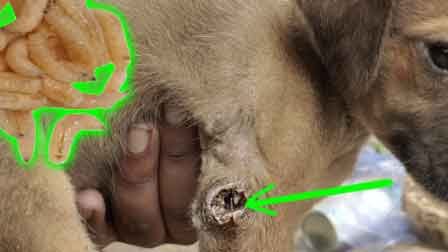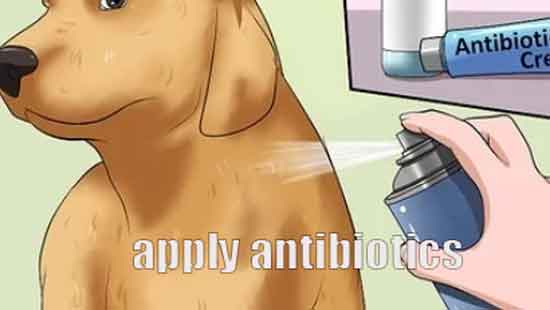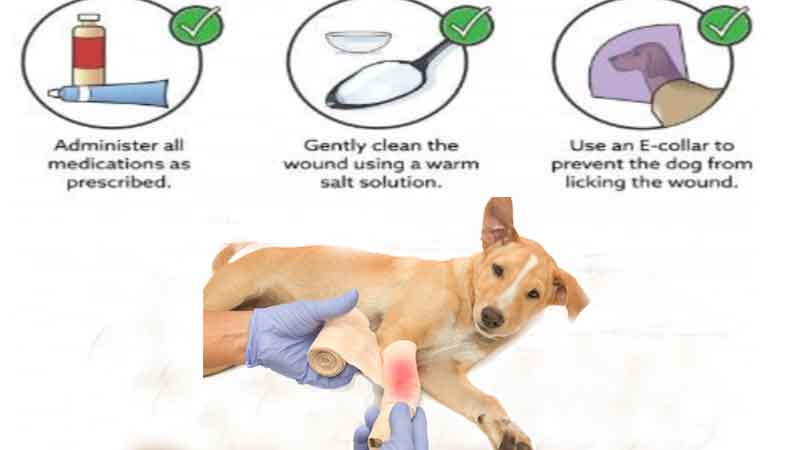Treating a Dog wound, especially with dirty maggots is not an easy task. Mostly street dogs would catch maggots to their open wound due to being left untreated and handling such conditions is not child’s play. Still, if you are brave and you have hope you can manage to treat a dog wound with maggots. Today in this post, we will share our expert guide to treating an open wound in dogs that has maggots in it.
So, read these guides and get an overall idea of the situation, and then perform the treatment with proper information. If you are not confident enough, you can get help from YouTube videos or from an expert. So, without any delay let’s start our guide on How to treat a dog wound with maggots.
More: How to Treat Dog Flea Bites at Home without Medicine
How does a dog get Wound?
To treat a dog wound, we should know how a dog possibly gets a wound. A dog with a wound is one of the most common things. They always run around and get cuts during their playtime. Common canine wounds such as open cuts Minor cuts, and minor lacerations are very common in dogs.

Mostly street Dogs suffer from large wounds every now and then which can get easily infected. Most of the time, this can happen because of a fight, getting hit by a car, getting injured due to a sharp object while running, or aggressive activities like fighting. Minor scrapes may also occur from time to time due to running and playing.
Wounds if left untreated
An open wound or a deep cut can get worse and may be a threat to your dog’s life if it is left untreated. Any minor scrapes to a deep cut will get infected and will turn into abscesses. This will eventually turn the wound into a swollen baggy puss just around the infected wound, you may also notice a bad smell from the discharge of the wound.

Now, you may have come across dogs licking their own wounds right? It is important as a pet parent that you don’t let your dog lick their wounds, dogs will lick their own wounds as they itch, and licking will help take away the dirt from the open wound and soothe the pain but there are no such healing properties present in dog’s saliva, excessive licking can lead to irritation and further damage of the tissue around the wound.
Chewing on the wound will eventually lead to reopening the cut and slow down the process of healing.
So, to treat a dog wound with maggots, first of all, always maintain the hygiene of the wound.
More: 5 Best Tricks to Remove Ticks for Dogs
How do dog wounds catch maggots?
A consistent dirty wound or minor scrapes can lead to maggot infection, maggots are nothing but the eggs of flies. Flies or insects lay their eggs on unhealed wounds. It takes 1-3 days for the eggs to hatch and the larvae or maggots feed on the flesh of your live pet.
At first, they will feed on dead skin later on they will eat away the flesh of your dog quickly and they multiply faster than you can imagine if left untreated. This can cause the untimely death of your pet. Make sure not to touch the maggots with bare hands as they can infect human tissues which will cause a disease known as myiasis.
In these cases, to treat a dog wound with maggots, one may face a lot of difficulties. It is always better to treat a dog wound before it catches maggots or better protect the wound from fleas or other insects.
Can maggots kill a dog?
Unfortunately, yes it can. If your dog’s wound has been left untreated for a while now and infection has set it in, your dog probably has septic. Sepsis is an infection that takes lots of antibiotics to reverse. Maggots are attracted to such wounds as they feed on the flesh. In most cases, pets are in severe condition when you finally visit a vet.
It is possible to save a dog’s life until the maggot has eaten away a major part of the flesh or any organ of the body. In extreme cases of Maggot infection, there is usually a huge amount of blood loss leading to anemia which will kill your pet.
How to Treat a Dog Wound with Maggots

list of medicines and treatments for maggot wounds:
Begin with a thorough hydrogen peroxide flush and cleaning of the wound.
Carefully remove maggots by hand.
After removal, apply Neosporin or Negasunt powder to the wound site.
Once a day, either apply a thick paste of Himax ointment or use Dmag spray.
Administer Augmentin 375mg once daily.
Depending on your dog’s health status, give Neomac 1 tablet every 4-7 days.
Include Malobest 2.5mg as part of the treatment plan.
Consider the use of Liv52 tonic.
After the wound has healed, apply Topicure spray as needed.
Remove All the Maggots by Hand or a tweezer:
To treat a dog wound with maggots, The primary care for maggot-infested wounds is the physical removal of the maggot with a tweezer. This process only works if you come across a small maggot infestation. In case the wound has a large number of maggots, try removing most of the maggots quicky.
Do not keep removing the maggots for a long time as your pocking can harm the wound and make it worse.
Apply Antibiotics:
Now begin with treatment first, you need to flush the dirt on the wound with hydrogen peroxide or saline water thereafter use Dmag spray and apply a thick layer of betadine ointment or Himax ointment, along with Neomac tablets depending on how your vet prescribes.
Remember, dead maggots are easy to remove. Maggocide ointments are usually made to kill maggots. It is hard to pick out a huge amount of live maggots from wounds which can take hours if started. Dmag or maggocide ointment is nowadays popularly used in case of maggot infestation.
Try removing the maggots. Then apply a thick layer of Maggocide ointment on the wound. Try applying the ointment into the deep, where maggots could be hiding in the small holes of the wound and covere it with bandages.
A day after the bandages are taken out of the wound and this process by far has already killed all the maggots in the wound,
Wash the wound and Repeat:
A gentle wash into the wound hole is all that you need to get the dead maggots washed away. Ultimately Your vet may prescribe antibiotics such as doxycycline or Amoxicillin as per the age and weight of your dog. A day-to-day proper cleaning is necessary for the wound to heal faster.
And that is how we clean a maggot-full wound in dogs and treat a dog wound with maggots.
News: ‘There are no doctors to look after them’
How to Remove Maggots from a Stray Dog
How to remove maggots from a dog is the first thing you have to do. If you suspect that your dog has maggots, also known as myiasis, it’s important to act quickly as this can be a serious condition that requires veterinary attention. Maggots are fly larvae that can infest open wounds, sores, or areas with poor hygiene. Here’s what you should do to treat a dog wound with maggots-
Isolate the Dog: If possible, isolate the dog to prevent further infestation and to keep the infestation from spreading to other animals or areas.
Maintain Cleanliness: Keep the affected area clean and dry. Maggots are attracted to moist, warm environments. Clean the area gently using a mild antiseptic solution, but do not use anything without consulting your vet first.
Medical Removal: If the maggots are visible on the surface, your veterinarian might remove them manually. This is often done under anesthesia to minimize stress and pain for the dog.
Preventative Measures: To prevent future infestations, ensure your dog is kept clean and dry, especially if they have open wounds. Regularly inspect your dog for any signs of wounds or sores and promptly address them.
Keep your dog safe from maggot infestation-

These are some precautions to prevent maggot infestation in a dog wound. Keep in mind all these points to safeguard a dog that has an open wound-
- Keep a check on your dog every time he goes out.
- Check if there’s is a cut or any tiny scrapes
- Do not ignore a minor cut that will heal on its own.
- Apply antiseptic ointment or powder on every little cut on your dog.
- Keep the wound or cut clean until it heals.
- Do not use unnecessary home remedies which can worsen the case.
- The usage of turmeric nowadays is not recommended as it contains chemicals.
- Seek medical attention or call your vet for primitive care which can be solved in a week at home.
FAQ
Q: What should I do if I discover maggots in my dog’s wound?
A: If you find maggots in your dog’s wound, it’s essential to seek veterinary care immediately. Do not attempt to remove the maggots yourself, as improper removal can worsen the situation.
Q: Can I use home remedies to treat a dog wound with maggots?
A: It’s not recommended to use home remedies for treating a dog wound with maggots. Professional veterinary care is necessary to properly assess the wound’s condition and provide appropriate treatment.
Q: Is maggot therapy a viable option for treating my dog’s wound?
A: Maggot therapy, when conducted by a trained veterinarian, can be a valid treatment option for certain wounds. However, its suitability depends on the wound’s severity and the dog’s overall health. Consult your vet to determine if this therapy is appropriate.
Q: How can I prevent maggots from infesting my dog’s wound?
A: Regularly inspect and clean your dog’s wounds, especially during warm weather when flies are more active. Keeping the wound clean and covered can help prevent flies from laying eggs and producing maggots.
Q: What will the veterinarian do to treat my dog’s wound with maggots?
A: The veterinarian will examine the wound, assess its severity, and determine the best treatment approach. This may involve maggot removal, wound cleaning, antibiotics to prevent infection, and other necessary medical interventions.
Q: Can I remove the maggots myself using tweezers or other tools?
A: You can perform a maggot removal with tweezer but be very careful. Read our guide for how to remove maggots from a dog first. However, It’s not advisable to remove maggots yourself.
Final Words: In conclusion, the presence of maggots in a dog’s wound is a distressing and potentially dangerous situation that requires immediate attention and appropriate care. Maggots, while commonly associated with decay and uncleanliness, can actually serve a purpose in wound management when used under controlled medical conditions for maggot treatment in dogs.
Prevention is still the primary concern to avoiding maggot infestations in wounds. Regularly cleaning and inspecting your dog’s wounds, especially in warmer months when flies are more active, can significantly reduce the risk of maggots taking hold. In cases where maggots are already present, seeking immediate veterinary care is crucial.
We hope you liked this guide on How to Treat a Dog wound with Maggots. Read our other helpful blogs on dogs on PawFactsnGuide to learn something new.

